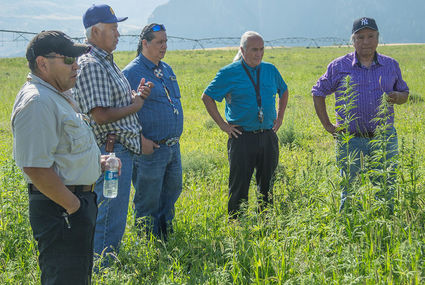Colville Tribes enters growing hemp industry
Last updated 8/30/2017 at 9:38am

Members of the Colville Business Council stand in the middle of a hemp field on Tuesday, Aug. 22. Pictured from left are: Larry Allen, Edwin Marchand, Andy Joseph Jr., Willie Womer, and Chairman Dr. Michael Marchand. - Jacob Wagner photo
The Colville Confederated Tribes is now the first tribe with a permit to grow hemp, and growing some of the only hemp in the United States today.
The U.S. hemp industry is estimated to have brought in $688 million in revenue in 2016 and has been steadily growing by about 25 percent a year, with projections at $1.8 billion in 2020, according to Hemp Business Journal.
A 60-acre organic hemp crop growing in the Swawilla Basin near Keller Ferry is the first step in researching the possibilities for the tribe in growing and processing the versatile flora, and expansion of the farm is already being discussed for next year with the possibility of up to 500 acres total across tribal land.
Hemp has a wide variety of uses, including paper, rope, fiber, plastic, foods, health and beauty products, building materials and more. Hemp is capable of producing four times the amount of paper per acre compared to trees, according to a 1916 U.S. Department of Agriculture study, and grows in a matter of months, not years like trees.
Hemp also has a deep history in the United States. George Washington and Thomas Jefferson, among others, grew the plant for its strong fibers. The first American flags were made of hemp.
Hemp's relation to marijuana, both varieties of cannabis, is the primary reason for its absence from agriculture in the United States since the 1937 Marihuana Tax Act was passed. With some exceptions, such as during WWII when rope and parachutes were needed and hemp fibers came in handy again, that act outlawed hemp along with marijuana.
Unlike marijuana, hemp has very low (0.3 percent or less) Tetrahydrocannabinol (THC) content. THC is the primary psychoactive chemical in cannabis, and the lack of it in hemp renders the plant unable to get someone high from smoking it.
Despite hemp not having the psychotropic effects of marijuana, the plants, each a different type of "cannabis," have remained illegal until recently; several states, including Washington, have legalized recreational marijuana, opening the doors to industrial hemp cultivation.
On the federal level, the Farm Act of 2014 allows industrial hemp to be grown for research purposes. That research can include a broad range of purposes, including learning about the many uses of the plant and how to grow and market hemp products.
Once the Farm Act passed, the tribal project came to fruition with work by, among others, Jackie Richter, who manages the tribes' conservation district and agriculture development, as well as attorney Michael Humiston, who made sure everything was done according to the law.
The tribe has already piqued interest in their crop from companies in the United States who would rather buy it in the U.S. rather than import it from other countries, such as China.
The tribe will be researching what processing they may be able to do themselves, but they may simply ship the harvest to other companies to process.
Washington state law doesn't allow the flower of the crop to be utilized, although federal law says it is OK. The flowers are one of the more lucrative parts of the plant because of their cannabinoid content. That chemical, abbreviated to CBD, has purported health benefits, such as pain relief, and is used in lotions, massage oils, and more.
Not allowing the cultivation of the flowers is just wrong, according to Doug Fine, the lead hemp consultant brought onto the project.
"In agriculture, imagine all the different things that tomatoes can be, from salad tomatoes to tomato sauce to sun-dried tomatoes," Fine said, standing in a 60-acre irrigated field of hemp. "Now imagine that there were rules saying you could only sun-dry tomatoes, but not sell fresh mini-tomatoes."
Members of the tribe performed a blessing of the hemp field Aug. 22, in which there was a smudging (a burning of sage, hemp, and possibly more sacred herbs) and two songs sung.
"We're here to bring our positive vibes and get the word out," said Colville Tribes Public Affairs Officer Meghan Francis before Scarbo Marchand sang a traditional song with a drum.
The tribe feels that the crop will bring money and jobs to their people in a positive, progressive, forward-thinking way that is healthy, good for the environment, and utilizes unused farmland.
"Medicine is grown with this plant, and that's a good thing," said Colville Business Councilmember Andy Joseph Jr. "I'm praying for Mother Earth and all she has to share with us, the jobs this will give to us, the good health benefits. I pray that our crop is really good. All living things are just like us, every blade of grass, every tree, every plant and animal. These seeds will be here for future generations. Think about all the good things we want, and this can help."

Hemp stalks, shown here, ranged from a few inches to a few feet high on Aug. 22, but are expected to grow to seven-eight feet. - Jacob Wagner photo
Joseph then sang a traditional food song.
"We just had the eclipse yesterday, and I think this is all part of the creator's plan, and we just have to keep doing what we're doing," said Colville Business Council Chairman Michael Marchand.
Packets of hemp hearts, or dehusked hemp seeds, were passed around and eaten as a gift from the Nutiva company. Hemp hearts are one of the reportedly healthy food products produced from hemp.
Stine presented samples of biodegradable plastic made from hemp, as well as a brick made from it. The automotive industry already uses hemp-based materials in various car parts.
A discussion of hemp then occurred casually among those in attendance, including a lawyer, businessmen and women, farmers, journalist, members of other tribes, people from another hemp farm, and others.






Reader Comments(0)